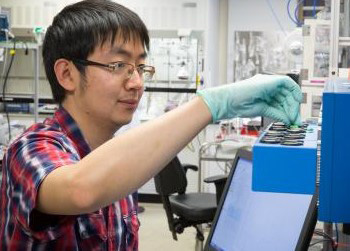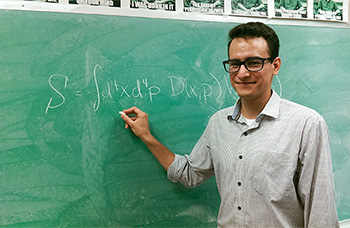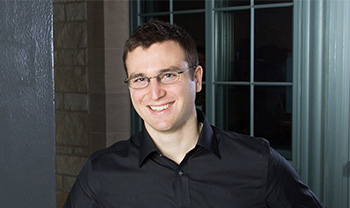2018 Truman Fellows boost mission-relevant research at Sandia

See also: About the Truman Fellowship
This year, three individuals will join the Truman Fellow ranks: Yiyang Li, Daniel Ruiz, and Ethan Secor. The three join the ranks of 25 other Fellows appointed since Sandia’s President Harry S. Truman Fellowship in National Security Science and Engineering was launched in 2004.
Because the fellowships are three-year assignments, four Truman Fellows are still doing research at Sandia as part of their fellowship. Additionally, 16 other Truman Fellows subsequently joined the Labs’ technical staff upon completion of their fellowship assignments; nine are still researchers at Sandia.
Yiyang received his PhD and MS in materials science and engineering from Stanford University in September 2016 and his BS in electrical and computer engineering from Olin College. His Truman Fellowship work is aimed toward developing a new class of smart materials whose properties are changed through electrochemistry. This is a fundamental new field of research, and the impact is to be able to dynamically and reversibly control material properties at the nanoscale, yielding novel smart devices with tunable material properties. The proposed work is aligned with Sandia’s research interests in smart materials. Yiyang will begin his fellowship this month in Materials Physics Dept. 8342 under the mentorship of Farid El Gabaly Marquez and manager Christian Mailhoit. Yiyang discusses his research in more detail below.
Daniel will receive his PhD in plasma physics from Princeton University this month. His MA in astrophysical science, nuclear reactor physics, and lasers/optics/matter was obtained from Institut National des Sciences et Techniques Nucleaires and Ecole Polytechnique; his BA in physics engineering comes from Instituto Tecnologico de Monterrey.
Daniel’s Truman Fellowship research will focus on developing new theoretical models to better understand the basic physics of laser-plasma instabilities processes relevant to magnetized liner inertial fusion (MagLIF). Working with Sandia experts, he plans to implement his algorithms in Sandia’s high energy density physics codes used to design experiments on Z. This simulation capability would be the first of its kind. His mentors will be Michael Glinsky and manager Kyle Peterson in Radiation and ICF Target Design Dept. 1684. Daniel will begin his Fellowship in September 2017. See below for Daniel’s discussion about his proposed research.
Ethan Secor earned his PhD from Northwestern University in materials science and engineering in June 2017. He earned his BS from Drake University, with a double major in chemistry and physics. Ethan plans to design a general nanomaterial ink platform for integration into digital printing methods. This attempts to change the paradigm for ink and material discovery using high-throughput screening, much as high-throughput screening has changed the pharmaceutical industry. Ethan’s work will have applications in Sandia’s national security mission areas. His mentor will be Bryan Kaehr (a former Truman Fellow) and manager Randy Schunk in Advanced Materials Laboratory Dept. 1815. Ethan will begin his fellowship in October. For more about Ethan’s Truman research plans, see his comments below.
Andy McIlroy, former Div. 1000 Deputy Chief Technology Officer who oversaw the selection of the 2018 Truman Fellows, says, “Being involved in the interviews and interacting with the Truman Fellow candidates were easily the best moments in the last few weeks of the selection process. We look forward to great results from the game-changing research being proposed by Daniel Ruiz, Ethan Secor, and Yiyang Li. We are confident their research will help us advance our mission work in areas of fundamental importance to us and look forward to hearing about their accomplishments over the next three years and beyond. We are grateful to the selection committee for continuing to identify great candidates for Sandia’s prestigious Truman Fellowship.”
The Lab News recently asked each 2018 Truman Fellow to describe the work he intends to pursue at Sandia. Here’s what they had to say
Yiyang Li

Advances in chemistry and physics have given us the ability to precisely control various material properties. However, most material properties are static after synthesis and fabrication and cannot be subsequently modified. The creation of smart materials whose properties can be dynamically tuned and reconfigured can make revolutionary changes to society, with the field effect transistor being the most prominent example. Yet there are not many mechanisms by which materials can be dynamically modified.
As a Truman Fellow, I will explore new mechanisms of using ion movement in solids to make smart materials and devices. Inspired from lithium-ion batteries, such devices use current and voltage to control the chemical composition, which ultimately modifies the electronic and mechanical properties of the material. Reversing the current and voltage restores the material back to its original state. At Sandia, I will develop the foundational principles of smart materials utilizing ion movement. I will merge microelectronics with redox chemistry to create novel devices, concepts, and functionalities.
Daniel Ruiz

In recent years, the magnetized liner inertial fusion (MagLIF) experiment at Sandia has become one of nation’s leading experiments in inertial confinement fusion. In MagLIF, a pre-magnetized deuterium fuel is heated by a 2.5 kilojoule, 1 terawatt laser and is then magnetically imploded by a 19 megaampere, 100 ns rise-time current. This unique experimental platform has achieved extreme fusion-relevant plasma conditions hard to reproduce elsewhere. More excitingly, MagLIF still has room for improvement.
In particular, much work remains to be done to optimize the MagLIF laser-heating stage. Current experiments suggest that only a fraction of the laser energy is transferred to the fuel in MagLIF, while the rest of the energy is lost. The low-energy coupling is mainly due to the presence of laser-plasma instabilities (LPI), for example laser scattering. The development of a general understanding of LPI processes and the eventual leveraging of that understanding to optimize the MagLIF preheat is of central importance to the entire MagLIF campaign.
At Sandia, I will focus on developing new theoretical models to better understand the basic physics of LPI processes relevant to MagLIF. This research could lead to novel ways in which these processes can be controlled or even exploited in MagLIF. I will be working at the Pulsed Power Sciences Center with Michael Glinsky and Christopher Jennings. Overall, I am excited to begin my work at Sandia as a Truman Fellow. I am looking forward to collaborating with fellow Sandians and contributing to the scientific effort of this institution.
Ethan Secor

Additive printing of functional liquid inks offers opportunities for high-throughput and custom manufacturing of electronic components with applications in electrical wiring, sensing, displays, radio frequency communication, and smart packaging.
However, the complex interplay of materials development, ink formulation, and patterning technologies slows the implementation of this framework in practical settings. At Sandia, I hope to address this challenge by developing unique multimaterial printing capabilities and integrating digital patterning methods within a larger computational framework for high-throughput experimentation.
The Advanced Materials Laboratory (AML) at Sandia is at the forefront in the development of materials and methods central to this goal. Active research at the AML spans nanomaterial synthesis, ink formulation, and printing method development in an integrated environment ideally suited for comprehensive research in this dynamic field.
My research will focus on aerosol jet printing, an advanced patterning technique with strong ties to Sandia. By tailoring this method for multimaterial deposition, unique capabilities to print hybrid and composite materials will benefit efforts in both high-throughput materials science and electronic device fabrication. For this work, I’ll be directly supported by my mentor, Randy Schunk, and an interdisciplinary team of researchers at AML.
Seven years ago, I was introduced to Sandia during a summer research program, and the collaborative and engaging atmosphere of the Labs made a lasting impression. With the generous support, independence, and access to world-class researchers and facilities offered by the Truman Fellowship, I’m excited to return to Sandia to begin my scientific career.
About the Truman Fellowship
The Truman Fellowships are three-year appointments. Candidates are expected to have solved a major scientific or engineering problem in their thesis work or have provided a new approach or insight to a major problem, as evidenced by a recognized impact in their field. The program fosters creativity and stimulates exploration of forefront science and technology and high-risk, potentially high-value R&D and is funded by Sandia’s Laboratory Directed Research and Development (LDRD) Program. A panel of senior scientists and engineers reviews and ranks each application, interviews finalists, and makes a hiring recommendation to the Associate Labs Director for Advanced Science and Technology, Division 1000.
Applications are currently being taken for the FY2019 application deadline of Nov. 1, 2017.
The 2018 panelists were: Cynthia Phillips (Chair, 1400); Joe Michael (1800); Philip Kegelmeyer (8700); Tina Nenoff (1800), Tan Thai (5800); Phil Dreike (6700); Michael Desjarlais (1600), Hy Tran (2500), and Tom Kulp (8700).
Sandia’s CTO Programs Office (1171) and Human Resources (3555) teamed more than a dozen years ago to create the Truman Fellowship Program and develop the processes necessary to implement the prestigious position.
Truman Fellows in FY17 were Adam Backer (8631), Nick Burtch (8341), and Matt Hudspeth (1528).